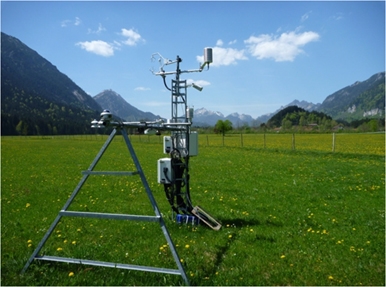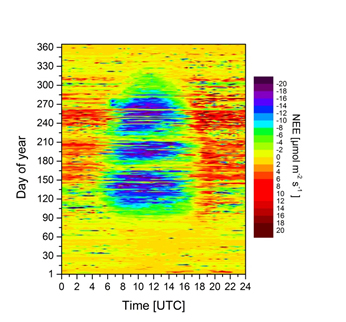Graswang

The Karlsruhe Institute of Technology (Institute of Meteorology and Climate Research-Atmospheric Environmental Research, Campus Alpin) operates four climate- and eddy covariance measurement stations within the TERENO Bavarian Alps/pre-Alps Observatory; three of these sites are also ICOS stations (Graswang, Fendt and Schechenfilz).
Fendt and Graswang are pre-alpine grassland ecosystems in the River Ammer catchment, representing the typical land use in this area. The elevation difference between Graswang and Fendt is about 260 m, leading to natural gradients in temperature and precipitation. These gradients are used to gain information about the effects of regional climate change on the greenhouse gas exchange. Furthermore, a lysimeter network is realized (36 lysimeters) at the River Ammer catchment, in which soil monoliths with grassland vegetation are translocated along the existing natural temperature and precipitation gradient, to study regional climate change effects on the coupled C and N cycles, the plant biological and microbial processes/populations/biodiversity involved in C and N-cycling as well as C- and N-trace gas production, consumption and emission.
The ICOS "associated site" Graswang (47.571° N, 11.033° E, 864 m a.s.l) is the highest elevated site in the Ammer catchment with a mean annual air temperature of only 6.8 °C but a high precipitation of 1531 mm per year (German Weather Service, long term mean 1981-2011). The site is located at the bottom of a narrow valley, leading to a wind system that is strongly influenced by the mountain - valley breeze. The grassland in Graswang is extensively managed with 2-3 cuts per year. The eddy covariance measurements (CSAT3 sonic anemometer and an open-path analyzer LI-7500 for CO2 and H2O flux measurements) and measurements of auxiliary parameters (e.g., radiation, soil heat flux, soil and air-temperature) started in November 2009. The vegetation development at the site is continuously monitored by a fish-eye web-cam. Near real-time data are available on http://tereno.imk-ifu.kit.edu/Graswang/.

The "fingerprint" of the net CO2 exchange (NEE) clearly presents the daily and annual cycle, as well as the reduction of the net CO2 uptake after the two grass harvests in June and August 2011. Yellow and red values are carbon emission, green and blue values are carbon uptake.